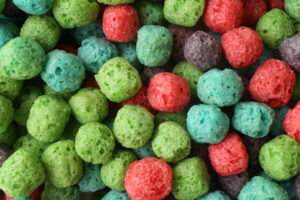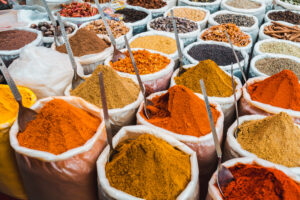The demand for natural colors has increased as consumers look for simpler, more understandable product labels. And while these can come from a wide variety of plant and mineral sources, there are several main types of natural colors that are most commonly used in foods and beverages. Below we’ll take you through the sources you are most likely to find in foods and beverages and how they perform in application.
Anthocyanins
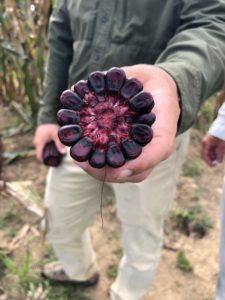
Anthocyanins are water soluble natural pigments responsible for the pink, red, purple, and blue hues of many flowers and edible fruits. The anthocyanin sources most commonly used for natural color production are purple corn, purple carrots, red radish, and elderberry. Other sources like cabbage and purple sweet potato can also be used.
Within each plant, these pigment compounds vary in concentration and exact chemical structure making them all slightly different when using them for color in a food or beverage. For example, purple sweet potato appears bright magenta pink in low pH applications, while others like purple corn appear bright red. They are all generally heat and light stable but anthocyanins from vegetable sources tend to be slightly more stable than those from fruit sources.
Anthocyanins are unique compared to other natural colors because the molecule slightly shifts in structure based on the pH that it is in, causing it to change colors from pink/red in lower pH levels to purple/blue in neutral/high pH levels. Watch it in action!
Betanins
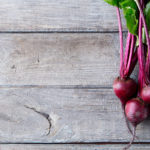
Betanins are the water–soluble pigments that give red beets, or beetroot, their bright red hue. They provide magenta pink to red shades in foods and beverages and are one of the most popular natural color sources, especially for applications like confections, yogurt, and frostings. These colors are generally very light stable but will fade during heat processing.
Red beet is often used as an alternative to Red #40 or Carmine when product developers need a vegetarian or Kosher friendly red source, but, because it can fade during heat processing, it is not ideal for applications like cakes and other baked goods that are subjected to high heat. You can learn more about the best alternatives to carmine for different applications here.
Carmine & cochineal
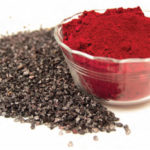
Cochineal and carmine are natural colors extracted from the cactus-dwelling female cochineal insect that is native to Latin America. Depending on the method of extraction, it can range in hue from orange to red to purple.
In terms of stability, this natural color source is one of the best – it has excellent heat, light, and pH stability and works well in a wide range of food and beverage applications, making it popular as a Red #40 replacer when kosher certification is not a requirement.
Carotenoids
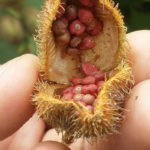
Carotenoids are one of the most frequently used types of natural colors. They are the pigments responsible for giving plants their red, orange, and yellow shades. For food and beverage purposes, they come from a wide range of natural color sources, including annatto, beta-carotene, and paprika.
Like Anthocyanins, within each plant, these pigments vary in concentration and exact chemical structure making them all slightly different, but they are widely used in the food industry because they are generally stable to heat, light, and pH. They are most commonly used in beverage, dairy, and savory applications or as natural alternatives to Yellow #5 and #6.
Chlorophyll
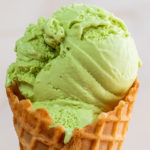
Chlorophyll is naturally found in the chloroplasts in green plants and its abundance in nature and vibrant green shade make it ideal for use as a natural food color. When originally extracted it is in an oil soluble form called chlorophyll but can be converted into a water–soluble version called chlorophyllin. Since chlorophyll[in]s are not the most stable or vibrant options for food or beverage applications, they can be stabilized by ‘coppering’ – creating copper chlorophyll and copper chlorophyllin. Learn more about the differences between these pigments here.
These are vibrant green options that have good stability to heat, light, and pH.
Curcumin
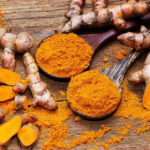
Curcumin, also called turmeric, is a vibrant yellow pigment extracted from the root of the turmeric plant, which is in the ginger family. Turmeric has a long history of use as a spice and as a medicinal supplement.
The extracted color has excellent heat stability, making it perfect for applications like bakery, soups, seasonings, and extruded snacks as well as frostings and confections. However, it performs best when it has opaque packaging because it will fade when exposed to light. Because this pigment is so vibrant, it can be used to create close matches to Yellow #5.
Phycocyanins
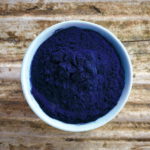
Phycocyanins are one of the newest types of natural colors to be approved but are already widely used in the food industry. They are the water-soluble pigments responsible for the blue color extracted from the algae Spirulina. This algae occurs naturally in freshwater and marine habitats and has a long history as a food supplement in many countries.
The extracted color is a vivid blue without any green or purple undertones. Despite its bright shade, Spirulina has limited uses because it is susceptible to fading in heat and light and is only stable between pH 4-7. It is most successfully used as a natural alternative to Blue #1 in applications such as ice creams, confections, and dry-mix beverages.





